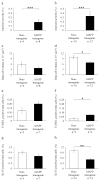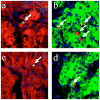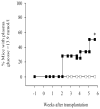Amyloid formation results in recurrence of hyperglycaemia following transplantation of human IAPP transgenic mouse islets
- PMID: 19002432
- PMCID: PMC4950742
- DOI: 10.1007/s00125-008-1185-7
Amyloid formation results in recurrence of hyperglycaemia following transplantation of human IAPP transgenic mouse islets
Abstract
Aims/hypothesis: Islet transplantation is a potential cure for diabetes; however, rates of graft failure remain high. The aim of the present study was to determine whether amyloid deposition is associated with reduced beta cell volume in islet grafts and the recurrence of hyperglycaemia following islet transplantation.
Methods: We transplanted a streptozotocin-induced mouse model of diabetes with 100 islets from human IAPP (which encodes islet amyloid polypeptide) transgenic mice that have the propensity to form islet amyloid (n = 8-12) or from non-transgenic mice that do not develop amyloid (n = 6-10) in sets of studies that lasted 1 or 6 weeks.
Results: Plasma glucose levels before and for 1 week after transplantation were similar in mice that received transgenic or non-transgenic islets, and at that time amyloid was detected in all transgenic grafts and, as expected, in none of the non-transgenic grafts. However, over the 6 weeks following transplantation, plasma glucose levels increased in transgenic but remained stable in non-transgenic islet graft recipients (p < 0.05). At 6 weeks, amyloid was present in 92% of the transgenic grafts and in none of the non-transgenic grafts. Beta cell volume was reduced by 30% (p < 0.05), beta cell apoptosis was twofold higher (p < 0.05), and beta cell replication was reduced by 50% (p < 0.001) in transgenic vs non-transgenic grafts. In summary, amyloid deposition in islet grafts occurs prior to the recurrence of hyperglycaemia and its accumulation over time is associated with beta cell loss.
Conclusions/interpretation: Islet amyloid formation may explain, in part, the non-immune loss of beta cells and recurrence of hyperglycaemia following clinical islet transplantation.
Figures





References
-
- Robertson RP. Successful islet transplantation for patients with diabetes--fact or fantasy? N Engl J Med. 2000;343:289–290. - PubMed
-
- Shapiro AM, Lakey JR, Ryan EA, et al. Islet transplantation in seven patients with type 1 diabetes mellitus using a glucocorticoid-free immunosuppressive regimen. N Engl J Med. 2000;343:230–238. - PubMed
-
- Ryan EA, Paty BW, Senior PA, et al. Five-year follow-up after clinical islet transplantation. Diabetes. 2005;54:2060–2069. - PubMed
-
- Clayton HA, Davies JE, Pollard CA, White SA, Musto PP, Dennison AR. Pancreatectomy with islet autotransplantation for the treatment of severe chronic pancreatitis: the first 40 patients at the leicester general hospital. Transplantation. 2003;76:92–98. - PubMed
-
- Westermark P, Eizirik DL, Pipeleers DG, Hellerstrom C, Andersson A. Rapid deposition of amyloid in human islets transplanted into nude mice. Diabetologia. 1995;38:543–549. - PubMed
Publication types
MeSH terms
Substances
Grants and funding
LinkOut - more resources
Full Text Sources
Medical
Molecular Biology Databases

